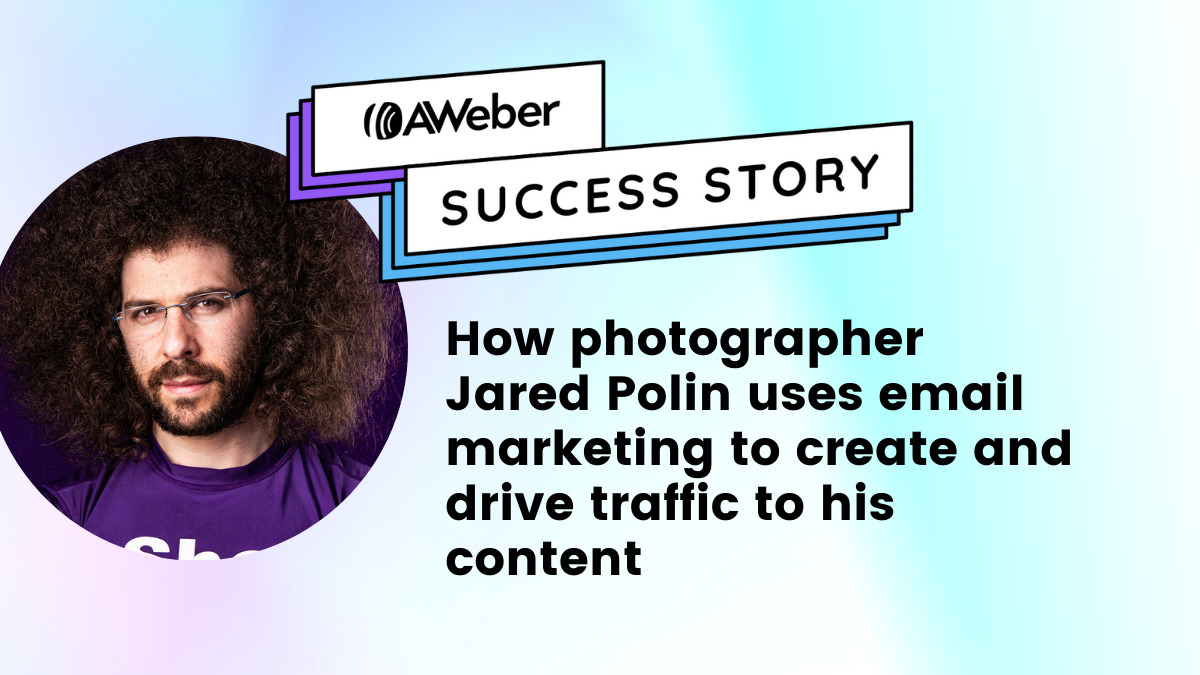
Jared Polin went from unknown Youtuber to one of the biggest names in photography.
His journey began in 2008, when Polin filmed a video of himself talking about his camera gear. It was awkward. He was visibly uncomfortable in front of the camera. But he kept going.
He created another video. And another, and another.
In 2010, he launched his website Fro Knows Photo to show off his photography expertise and land some freelance jobs. His following back then was non-existent, but he kept creating.
Slowly, people began to notice. They asked questions about his techniques and Jared answered them the best way he knew how: with videos.
Today, Jared has nearly 1.27 million YouTube subscribers and more than 260K email subscribers.
But his success didn’t happen overnight. He cultivated his following over time with incredible content, a smart marketing strategy, and persistence.
I’ll show you all of the tactics Jared uses and how you can apply them to your own marketing strategy.
Getting started with content creation
When Jared started Fro Knows Photo, he had no business plan. He didn’t wait until he could create the perfect video; he just started executing.
“I don’t have a business plan,” he said. “I have ideas of what I want to do and I go with it. I think the problem people run into today is they worry too much. It’s important to plan, but start executing. Start doing. Then iterate along the way.”
The sooner you get started, the sooner you can collect feedback. The sooner you collect feedback, the sooner you can pivot (if you need to).
The majority of Jared’s videos today are aimed at helping people take better photos. But education wasn’t his goal in the beginning.
“The idea was to put out content with the photos I was taking so I could get more jobs because businesses would see my work and try to hire me,” he said. “That didn’t happen. What happened was people started asking questions about photography. I pivoted right off the rim. People would ask a question, I would put a video out about it. It started to grow from there.”
If you’re having trouble discovering the direction you want to take with your content, find out where your ideal audience hangs out online – think forums, the comments sections of popular blogs and Facebook and LinkedIn groups. Get involved in those communities and pay attention to the questions people ask.
Is there a particular topic that people are dying to know more about – a topic that other blogs and businesses in your space haven’t adequately answered? Start there.
Jared’s following grew because of his consistent interaction with his audience from the very beginning. When in doubt, get feedback.
Takeaway: There’s no “perfect” time to start creating content. Begin by answering the biggest questions in your space and give yourself permission to improve over time.
Create content that stands out above the noise
If you‘re just starting to create content, look at what other people in your space are doing. What can you do better?
Jared knew he wanted to create videos reviewing camera gear. The problem with most review videos was they were painfully boring and unhelpful for most viewers.
“You can’t fake getting good photos,” he said. “If all you have are test pictures of lamps and grass, you’re not helping people. But if you show you can get fantastic results with the most entry level camera, you’re telling people, ‘You can do this yourself.’”
Jared’s videos resonate with people because they’re authentic. He doesn’t try to create perfect content, he creates honest content. (Case in point: here’s a video of Jared crashing a razor scooter.)
Whether you’re creating videos, ebooks or blog posts, your audience can tell when you’re faking it. And if there is no real takeaway that they can apply to their own lives, you’re simply wasting their time.
Takeaway: Is your content providing a real solution? Are you allowing your personality to show? Would you read it or watch it yourself? If you can answer “yes” to these questions about your own content, you can stand out above the noise.
Drive traffic to your content
Have a piece of content that you’re proud of? Awesome. Now let’s drive some traffic to it.
Jared knew that he could create great content all day, but if people couldn’t find it, it wouldn’t do anyone any good. He was no SEO expert, but he knew that the smart use of tags on the videos he uploaded on YouTube could get him better visibility.
“I knew if I could tag things smartly – ‘Nikon D3300’ for example – people are gonna look,” he said. ”But if I tag that same video as, ‘The first ever Nikon review, this thing is awesome,’ it’s not gonna match that many keywords. I didn’t know much about SEO, but all I did was common sense.”
No matter what type of content you’re putting out into the world, including keywords that reflect the way people search for those topics is key. Try Google Keyword Planner to discover your best keywords.
Another way to gain traffic is to publish content consistently, like Jared does.
“I was putting out quality, consistent content and that’s what kept people coming back for more,” he said. “You can’t put out one piece of content a week and expect people to latch onto you. They’re gonna forget about you. It would be very slow if you just put out one piece of content at a time.”
I mentioned earlier that Jared created new videos based on questions people asked him. That’s one of the main ways he was able to grow his following.
“When people had a comment, and it was a good one, I could make a video off of it,” he said. “Or people could submit photos I could critique, and that’s a piece of content I could put out into the world.”
Delivering consistent content gives people a reason to keep coming back. And when you create content based on your audience’s comments and questions, it shows them you’re paying attention. That’s the start of a beautiful relationship.
Takeaway: Put more content out into the world and be sure to include the appropriate keywords. Try creating an editorial calendar to stay organized. Here’s how you can create an editorial calendar to help you keep track of your content.
Use email to deliver your content
Jared relies on email – more than any other marketing strategy – to expand his reach, build relationships, and get more eyes on his content.
“Part of getting the message out was through email,” he said. “Expanding your reach is getting hard to do unless you’re paying for it. If you want to reach your people, one of the best ways to do that is through email.”
His email strategy? Jared includes an ask for email sign ups at the beginning of his most popular videos. Once someone is signed up, he sends them lots of valuable content up front for free. He’s such a believer in this tactic that for the first two years of Fro Knows Photo’s existence, he didn’t ask anyone to buy anything from him.
“The internet marketers said, ‘You have 5,000 people on your email list! You need to sell something right now!’” he said. “I wasn’t ready to sell. That was the mentality, five, six years ago: sell, sell, sell, sell, sell. I was like, ‘I’m gonna give, give, give, give, give.’ It took two years until I had a guide I wanted to sell.”
Jared offers lots of free content up front. On his sign up form, he offers a free lead magnet for a photography guide for capturing motion in low light situations – a topic that resonates with amateur photographers.

Jared’s guide provides the perfect starting point for anyone who just bought their first camera, so it’s no surprise that it’s helped build his email list to more than 260K subscribers.
Takeaway: Before you can even think about asking your subscribers to buy something from you, be sure to provide them with plenty of no-strings-attached content up front. Create an incentive to give people a reason to sign up for your list.
Keep your subscribers engaged over time with email automation
After Jared’s new subscribers get his free guide, he sends them a series of automated emails that span over the course of a few weeks. Here’s what his welcome email looks like:
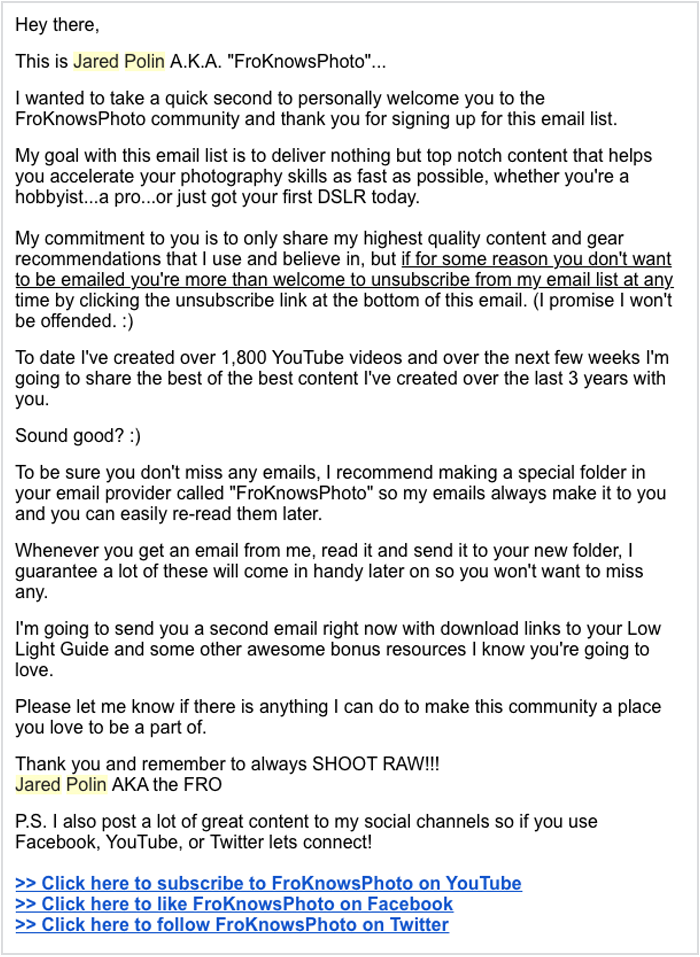
Jared tells people exactly what they can expect to see in their inbox from him. He even invites them to unsubscribe from his list if they don’t find his tips useful.
After that, he sends a separate email that contains the free guide and a bonus video with tips for getting press passes to concerts. More free, unexpected content. Pretty cool, huh?
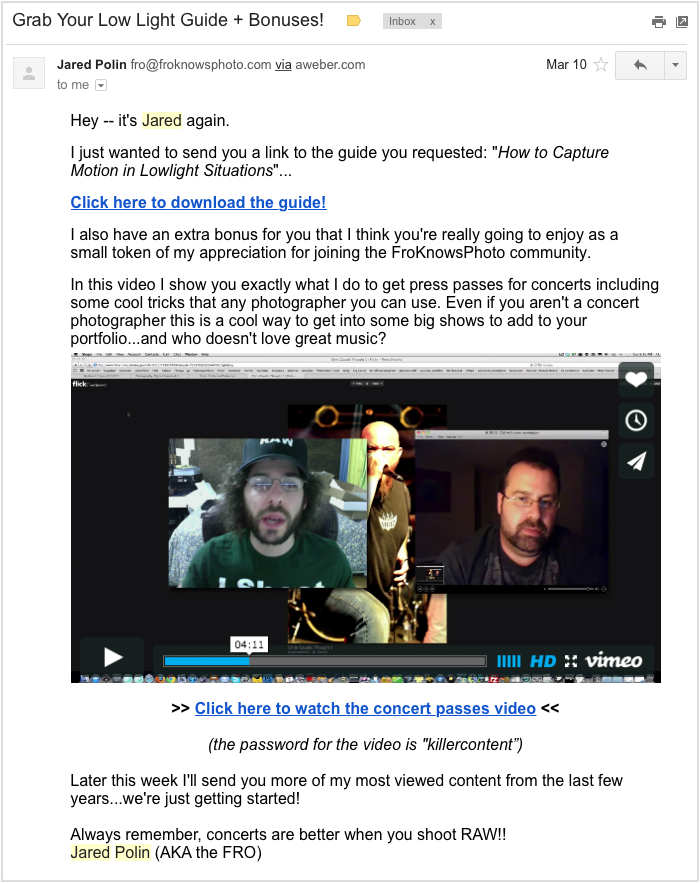
Jared then sends his subscribers an automated email series that delivers a new photography tip every day. Each email is short and each tip is something people can start using right away. Here’s one of those emails:
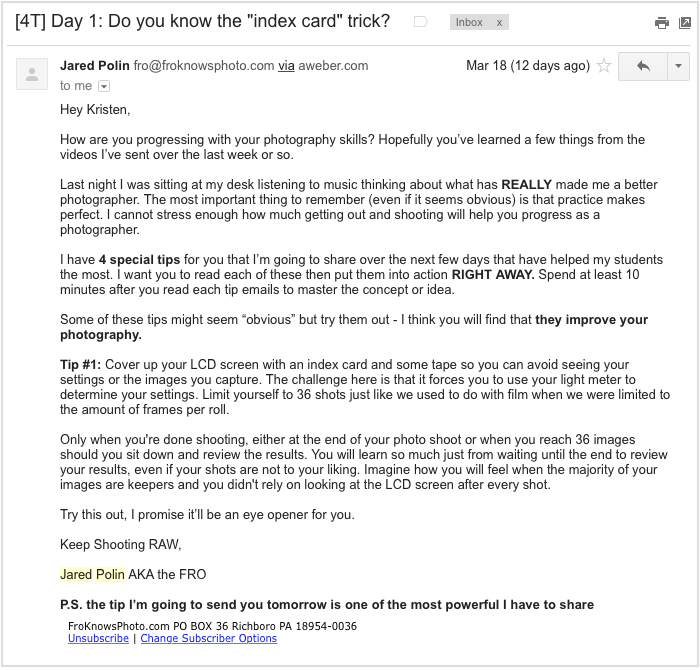
Jared is careful not to ask his subscribers to buy from him right away. When I signed up to his email list, I didn’t receive an email promoting his paid guide until more than a week later. By that point, I’d already received eight emails packed with free photography tips.
“The autoresponder series is built out over a few weeks,” he said. “I send solid content time and time again. Occasionally, there’s an ask in there, but then there’s more solid content. They also get the emails I create every week or every other week. Whenever I’m creating value, I use it. I don’t want to overpush.”
Takeaway: Email automation can help you build relationships with your subscribers over time. When you do promote a product, do it carefully.
Know your audience before you create paid content
Have a growing audience and a solid content strategy? Congrats! You’re on your way to monetizing your business with paid products or services. So how exactly can you make that happen, while balancing free content with paid content?
To answer this, we’ll look at how Jared created valuable paid content for his ideal audience and how he uses email to drive traffic to his sales page and, well, make sales!
When you’re asking your audience for their hard-earned cash in exchange for your content, you better make sure your content is worth their investment. The first step in developing valuable paid content is knowing your audience.
“98 percent of [my audience] is amateurs or hobbyists that love what they do and maybe want to make some money on the side,” he said. “I knew that was the largest area, so I may as well reach out to them because there are more of them. Professional photographers shouldn’t need that content. Continuing your education is important, but it’s a smaller market. It wouldn’t be smart to put out advanced guides because they’d have to be much more expensive.”
Since Jared’s audience is largely amateurs, it made sense to create a beginner’s video guide to photography that he could sell for a reasonable price.
Takeaway: Want to create valuable content that your audience will actually pay for? Get to know your audience first, thoroughly address their challenges in your content and offer it at a reasonable price.
Jared’s promotional emails in action
Jared uses email to deliver free content to his subscribers well before he promotes a paid product. This strategy has helped him cultivate raving fans and sell more of his paid guides.
Once a new subscriber opts into Jared’s email list, he serves them with about a week’s worth of free content. His subscribers get updates on the blog, podcast and new YouTube videos.
After that, he’ll occasionally promote his paid guides to his subscribers. Here’s how he promotes his beginner’s guide using email. Notice how he describes the benefits of buying his guide so that his subscribers know exactly what they’ll get if they buy it.
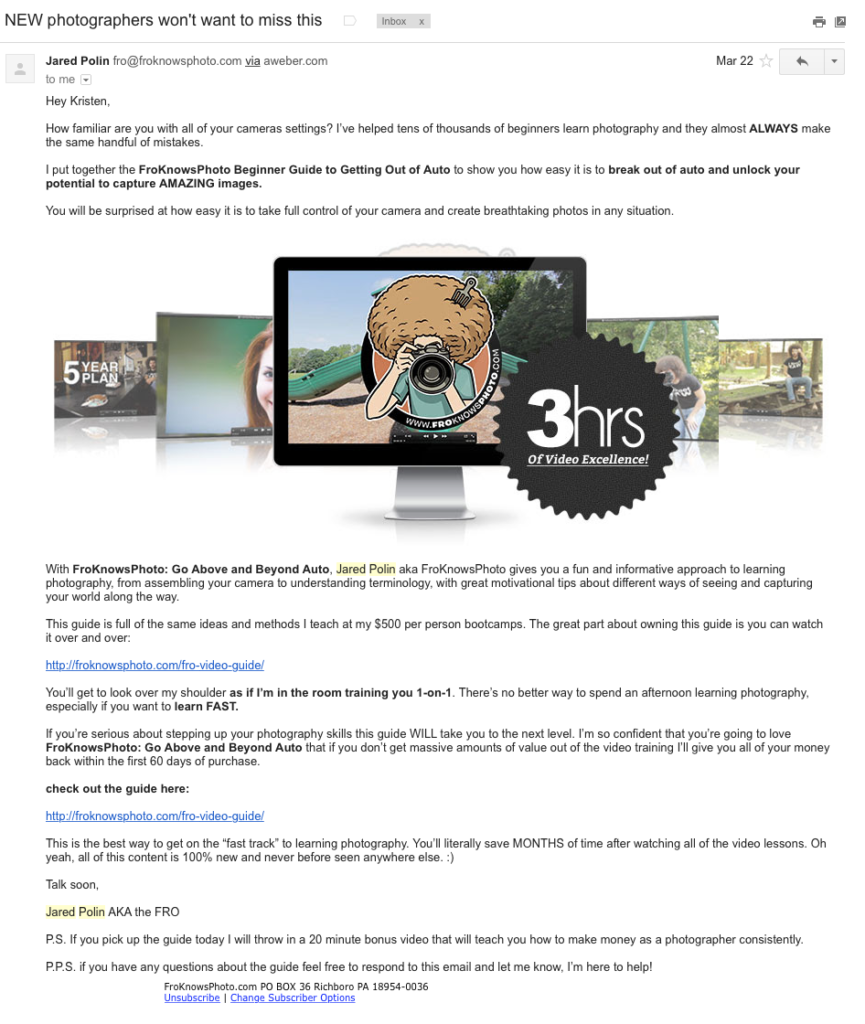
Here’s how Jared promotes his beginner’s guide along with one of his popular videos.
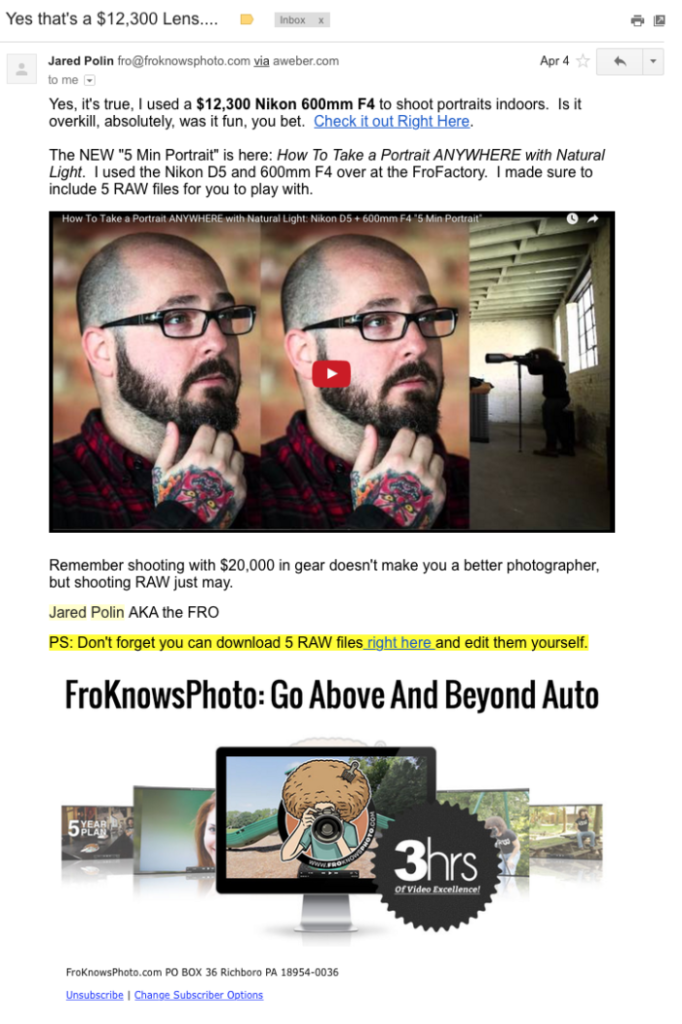
When Jared launched a new paid guide, FroKnows Photo Guide to Video Editing, he ran a limited-time sale on the guide to drum up excitement and get more sales. Those who didn’t buy the guide right away received this email with a countdown clock and a detailed list of reasons why they should purchase the guide.
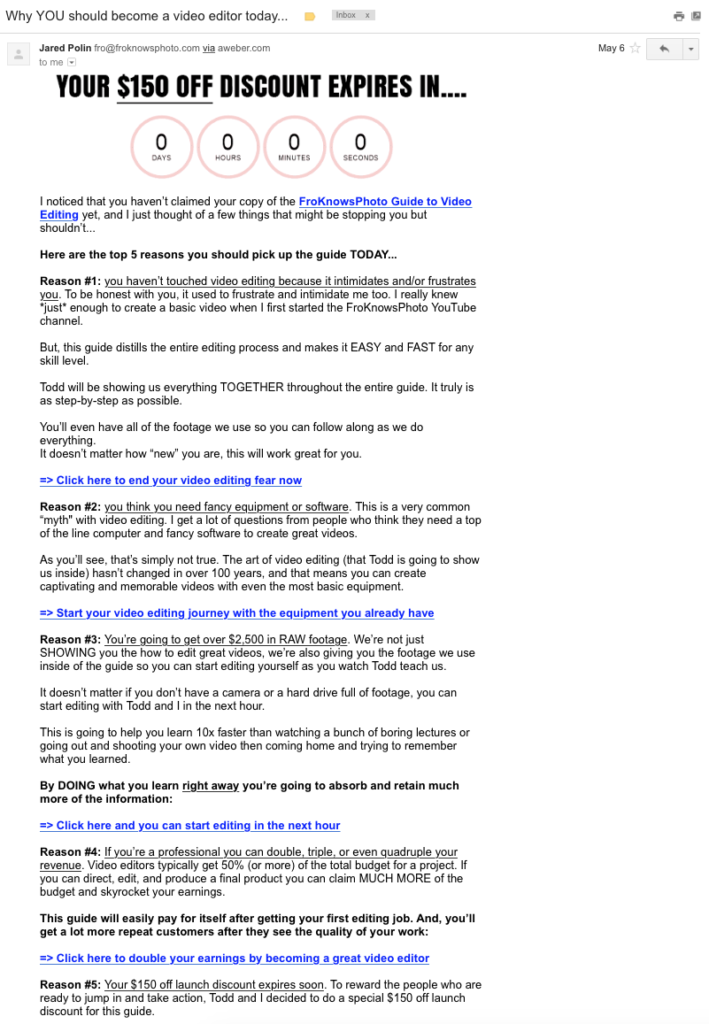
Jared has consistently seen results from this email strategy, time and time again.
“We know that it works,” he said. “We created a four-email sequence with a countdown timer and say what people have learned and here’s what you could learn. The last email that goes out four to six hours before the sale ends crushes it really hard because it has the countdown timer saying that it’s ending. We see sales happen because of that.”
Takeaway: Only promote your products or services after you deliver plenty of free content. Once you do promote your paid content, lead with the biggest benefits and explain in detail what your paid content has to offer.
Use YouTube to grow your email list
YouTube plays an important role in helping Jared grow his email list.
See how Jared Polin breaks down his email list-boosting tactics that landed him 260K+ email subscribers.
Turn your YouTube subscribers into email subscribers
You already know how email marketing can help you promote your paid products. So how can you get your YouTube subscribers to sign up for your email list?
It all ties back to the marketing funnel. Your YouTube videos provide awareness. Your viewers initially may not know anything about you or your business, but your video content piques their interest. If they like what they see, they’ll consider getting to know more about you.
At the beginning of many of Jared’s videos, he asks his viewers to sign up for his email list. He sometimes even includes a clickable image of his form in his videos, as shown here.
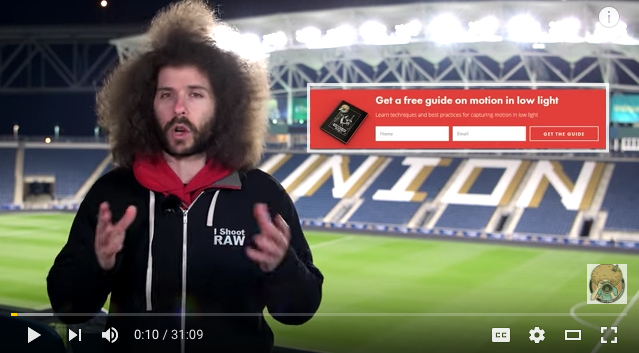
Once a viewer clicks on the sign up form image, they’re taken to the landing page on Jared’s website where his video lives. in this case, he includes a Nikon D5 “Real World Review” – where you can sign up for a free photography guide that expands on the content he discusses in the video.
Pretty ingenious.
Here’s what that page looks like:
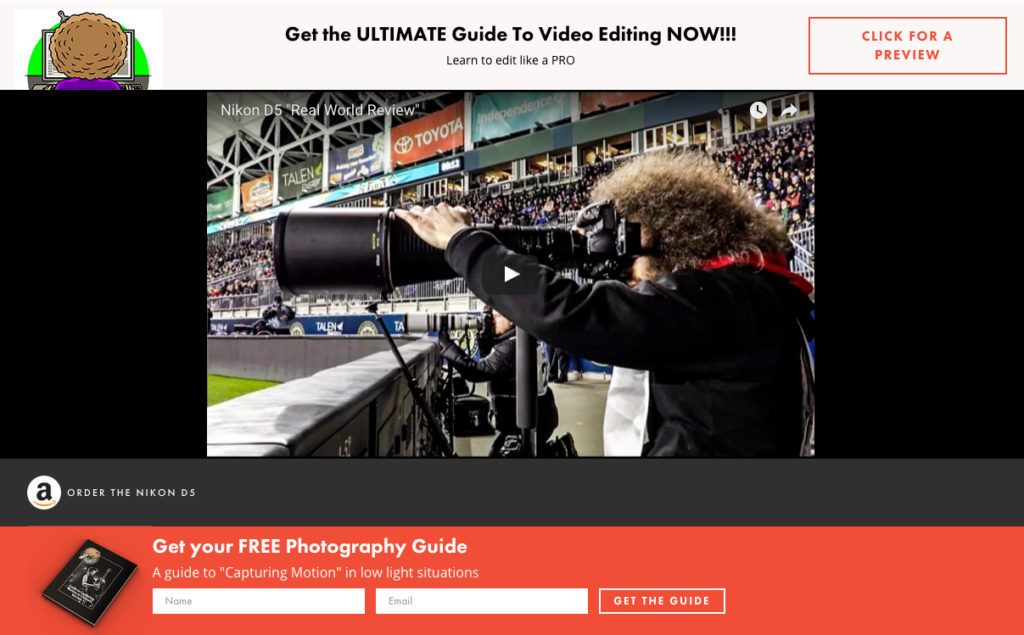
“On YouTube, it’s all about the ask,” he said. “I’m putting out a piece of content and people are watching it. But before the video starts, in the intro, I say, ‘If you haven’t signed up for the Fro Knows Photo email list on the website, please put your name and email address in it and I’ll send you a free guide to capturing motion in low-light situations.’”
Jared makes sure to add a sign up form to his most popular videos to ensure higher conversions. But some video content drives more conversions than others.
“The videos that convert the most sign ups for me are the preview videos,” he said. “Right away, I see a huge spike where I get 450 sign ups organically throughout one day. It may go to 450 or 500. You can’t know which content is going to be the most popular. That’s why you put the ask at the front of most videos. For me, I know that people are always searching for different lenses. If they find me for the first time, I want to have that ask in the beginning of the video.”
Takeaway: If you’re just starting to create video content for YouTube, ask your viewers to sign up at the beginning of all of your videos to grab every conversion opportunity possible. As you continue creating video content, you’ll be able to identify what content will be the most popular, and you can test different types of sign up forms and incentive offers.
Diversify off of YouTube
Once you have a YouTube following, it's important to keep those followers engaged both on and off of YouTube so you can build profitable relationships with them.
“If you’re just starting out on YouTube, you need to figure out how you’re going to get off of YouTube at the same time,” Jared said. “You use YouTube as a way to build a following. But if you’re not cultivating a following and getting off of that platform, you’re not doing yourself any good. Unless you’re one of the biggest YouTubers in the world and you’re getting hundreds of thousands of views a day, you’re not making money.”
Case in point: Jared has 1.27 million YouTube followers, and while most of his content is on YouTube, he doesn’t rely solely on YouTube to monetize his business.
“I knew I had to create my email list. I knew I had to get off of YouTube and not just live there,” he said. “That’s one of the downfalls of a lot of YouTubers. They hustle and do the YouTube angle without trying to get out of there.” “I still have the ability to do business because I have my email list. I have my other social integrations. It’s important to diversify off of YouTube.”
Even if you’re just getting started with YouTube, it’s important to think about how you’ll engage your followers elsewhere. Email marketing gives you the perfect opportunity to keep your YouTube subscribers engaged and turn them into loyal, paying customers.
Run contests to attract new subscribers fast
Contests are one of the best ways to grow your email list in a time crunch. Jared runs contests when he wants to give his list a boost fast. While he runs contests on a larger scale with camera giveaways valued at $2,000-$3,000, businesses at any stage can use contests for subscriber growth.
“Contests where I’m giving away two or three thousand dollars worth of camera gear are an investment,” he said. “But I’m getting sign ups that will build my following, build my email list.”
When Jared wants to boost his contest even more, he runs Facebook ads to them.
“That’s one of the only advertising things that I do,” he said. “We run Facebook ads to the contest and it just spreads. Where I normally get 150-200 sign ups per day, you’re looking at 2,000 people signing up for your email list. Then they get into my autoresponder sequence. My autoresponder emails aren’t meant to just sell, they’re meant to cultivate the value, ask for the sale at certain points, and keep people coming back for more.”
You might be wondering about the people who enter contests because they want free stuff – not because they’re interested in your business. This is one of Jared’s concerns, too.
“My concern with running those contests has always been people who just want to kick the tires because they want to enter for free,” he said. “Those people who enter for free are gonna unsubscribe anyway. But if I’m getting a 20 percent conversion rate with 100K subscribers and I’m still able to keep that conversion rate with 200K subscribers, that’s what matters. Contests are powerful.”
If you’re thinking about running a contest and you’re concerned about collecting weak leads, consider running a reactivation campaign and cleaning up your list afterwards to ensure your subscribers are engaged and you’re not hurting your deliverability.
Start using email marketing to grow your business
Running a business is like working two full-time jobs. Sometimes it may be a challenge to dedicate the time and energy into marketing your business. We’ve made it a little easier for you with this guide: “How to grow your business with email marketing.”
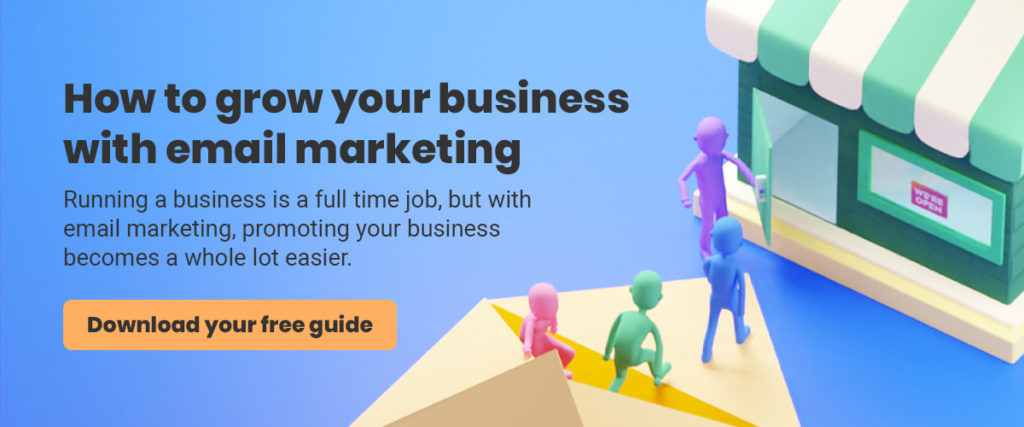
source https://blog.aweber.com/case-studies/create-and-drive-traffic-to-content.htm
No comments:
Post a Comment